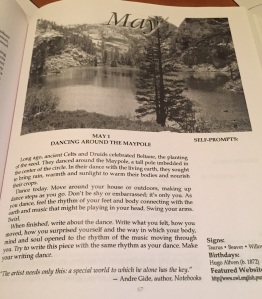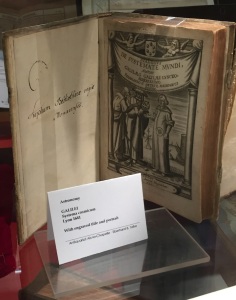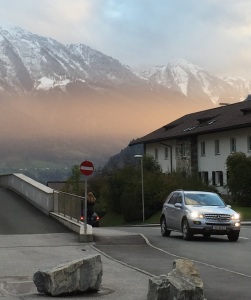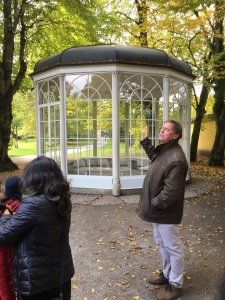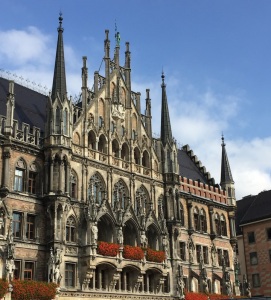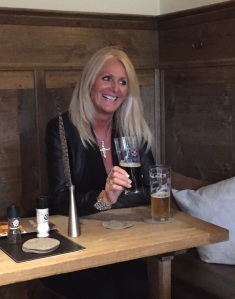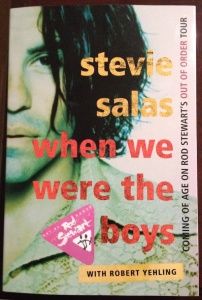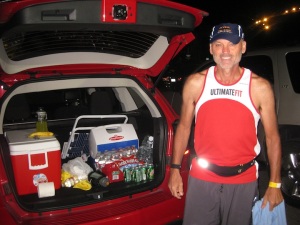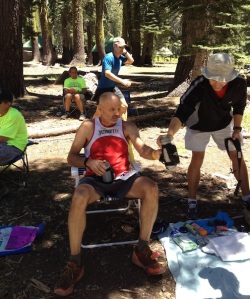Sometimes, we arrive at the idea for a novel and promptly write it, moving from concept to cover in a short period of time. In many ways, that’s the hook of independent publishing.
That has not been Stephen Gladish’s experience. The Tucson, Arizona-based author of the forthcoming Tracking the Skies for Lacy (On Sale August 28) has spent the past decade working with a central premise: his adventures with the Air Force’s Sixth Weather Squadron, and how romance, faith and harrowing missions seemed to mix.
![]() Like many authors, Gladish struggled with deciding when to finish and release his work. First, there is a lot of story; Tracking the Skies for Lacy is the first of three forthcoming romantic military adventures in the series. Second, his protagonists weave in and out of all three books, creating a delicious read to mind and heart that takes awhile to present as seamlessly as Gladish does.
Like many authors, Gladish struggled with deciding when to finish and release his work. First, there is a lot of story; Tracking the Skies for Lacy is the first of three forthcoming romantic military adventures in the series. Second, his protagonists weave in and out of all three books, creating a delicious read to mind and heart that takes awhile to present as seamlessly as Gladish does.
Most of all, Gladish wanted to get it right. Now, the retired English and writing instructor in the Arizona Department of Corrections system brings out the beautiful, thrilling and ultimately redeeming story of Luke and Lacy, and their windy road to romance. He also brings us the lushness of Polynesia, harrowing thrills of chasing tornadoes, a critical return to Vietnam, and more, in typical Gladish fashion — large, sweeping, ringing with imagery, and constantly working the heart strings.
Tracking the Skies for Lacy is coming out in time for us to reload on our summer reads. Perfect timing, as the enduring warmth of this story feels like a day at the beach — but one that makes us wiser when we finish reading.
Word Journeys: You went through a few ideas before settling on the final title, Tracking the Skies for Lacy. Could you elaborate?
Stephen B. Gladish: The military weather focus of Tracking the Skies for Lacy began long ago with my tours of Tornado Alley. Then I extended the scope to chasing tornadoes, monitoring nuclear detonations, flying helicopter rescue and attack missions, and making white water rescues. The unique romance of Luke and Lacy spanned all the new adventures and held them together. And each one of these chapters involved tracking the skies.
WJ: Where did the central idea for the book come from?
SG: In addition to my childhood inspirations, and my lifetime interest in weather, I wanted to call attention to the importance of weather in everybody’s lives. I served in the USAF 6th Weather Squadron (Mobile) and the Severe Weather Warning Command in the early Sixties. I want to take the reader through the sheer adventure of Luke growing into a man, just as the military venue designs it. From a weather warrior, he graduates to become an officer and a pilot, one of the few who came home from the Vietnam War psychologically unscathed.
WJ: Tell us briefly about Tracking the Skies for Lacy.
SG: Tracking the Skies for Lacy begins with a cloudy sky, metaphorically speaking. Lacy’s wealthy family moves to Luke’s hometown and they attend the same school, Park Avenue Prep. Lacy is beyond beautiful, and Luke, a handsome star student and athlete, is drawn to her. At age fifteen, Luke is confronted by class structure for the first time: Lacy is told by Mr. De’Luca, her father, not to have anything to do with any boy beneath her status. Thanks to Mrs. De’Luca’s compassion for Lacy, Luke and Lacy have years of hidden closeness.
Lacy goes on to Stanford University, while Luke follows a family tradition and joins the Air Force. Running a military gauntlet of tornadoes, nuclear atmospheric explosions, wartime helicopter actions, and white-water rafting dangers, Luke follows his quest to bring back the love of his youth. Lacy graduates from Stanford University, then shocks everybody by joining the Peace Corps. A wealthy girl, she lives in huts, rides on rundown old buses. A future with Luke? Luke could be swallowed up by Lacy’s family and disappear. Lacy has to give up a total life style to turn the corner.
Two years later, Luke comes home for a two-week R & R respite from the Pacific Nuclear Proving Ground/Marshall Islands. He had fallen in love with the beautiful and educated Talia Su’sulu, a Samoan teacher. He knew there would be no cross-class clash. But then there was Lacy…
WJ: The dance between Luke and Lacy becomes the romantic tension that holds throughout the novel.
SG: Our hero falls in love with Lacy, grows up, and becomes a Sixth Weather storm chaser. He and his military sidekicks locate and record deadly tornadoes while saving numerous people in the nation’s Tornado Alley, and then they are island castaways recording nuclear detonations all over the South Pacific. Lacy is miles ahead of Luke. He plunges into college and intensive helicopter training. Now as an officer, Luke and his buddies hunt down the deadly enemy in Vietnam, and then attend a reunion where Luke finally connects with Lacy. But the story is not complete until he and his buddies coordinate a stunning rescue as white-water guides on “The River of No Return.”
WJ: Could you talk about how you transferred your experience into the characters of Luke and Chance?
SG: Sure! It was primarily in the military part of the story. Luke and Chance had advanced training in upper atmosphere weather, as I did. We worked alone and isolated and became close for that reason as well, a camaraderie and brotherhood you see in the book. I feel we need a lot more of that today. In Sixth Weather Squadron, we repeatedly surveyed the drastic damages of tornadoes. Saving lives was a key part of our mission. Across the world, pilots and aircrews depended on our weather reports and forecasts. We had mission and meaning in our lives. We got hooked on it, to be quite honest.
WJ: Typically in romantic adventure novels, the story is set in one or two truly romantic places. In Tracking the Skies for Lacy, though, you mix it up. We’re in Chicago, Oklahoma, Vietnam and Northern California — quite a mix of landscape and feeling — but we’re also in Samoa and briefly in Hawaii. Luke falls hard for the simple Polynesian life. Tell us how the paradise settings fit into the story.
SG: In my view, Polynesia was not only a visual paradise, but also a beautiful family-oriented place. The grandfather, or matai, guided the family. Children were raised by the whole family. One family could adopt other kids with no paperwork. Life was gentle. Lovemaking was natural, innocent, and an accepted part of the island culture. Unlike the U.S., there were no constant comparisons of income or status or the homes in which everybody lived. There was little unrest or unhappiness with one’s job, or career, or position. Natives were natural teachers, nurses, caregivers. Trained teachers were prized, valued, and respected far more than teachers here. Church leaders and pastors and ministers were treasured, churches filled with white-clad Polynesians who sang with a childlike devotion and a sublime beauty you have to hear in person to believe. I really wanted to present this life in the novel.
WJ: If you were to bounce around a library, comparing your novel to others, what would you come up with?
SG: Many of Louis L’Amour’s stories, like Sackett and To Tame a Land, carry an innocent young man with strong moral values into situations where he must prove himself as a man in order to win the woman he loves. And all American literature for boys begins with Huckleberry Finn, the story of an innocent boy running away from his Pap and into freedom. Herman Melville’s Typee, the first romance novel based in the South Pacific, has an innocent and moralistic hero as well. The Jason Bourne character from the Robert Ludlum series has parallels with Luke LaCrosse: masculine qualities, adventurous and ambitious, needs to win. Furthermore, Luke’s odyssey, like Ulysses’, involves one challenge and temptation after another, tortuous romance sailing through numerous reversals, crashing , picking himself up, setting sail again.
WJ: The two principal romantic interests, Luke and Lacy, as well as others, hail from the Chicago area, where you also grew up. Even though you have not lived in Chicago in many years, it still holds you in many ways. Could you share what the city means to you, and the sentiment you wove into the novel?
SG: Frank Sinatra once sang, “Chicago is my kind of town.” And then he repeats it. Hey, it is my kind of town too. Any time I leave, Chicago tugs my sleeve. It is the kind of town that won’t let you down. Carl Sandburg was right: Chicago is a big-shouldered man. He is stormy, husky, and brawling. He is a wildly delinquent Paul Bunyan the Lumberjack, remembered around the country with a twenty-foot high statue. He can outwork anybody, and fiercely wields an axe left and right, up and down, to reach his goals. Whatever he destroys he builds up with something else new.
WJ: Your novel provides a fictionalized account of military service we often don’t hear about — forecasting the weather and studying it. Since you were a ‘tornado chaser’, a member of the Sixth Weather Squadron, what is particularly concerning to you about climate change today?
SG: I spent a lifetime of study, especially on the cruel euphemism “global warming,” a blurred, imprecise way of “dumbing down” the debate. The real definition is catastrophic climate change. Global emissions of carbon dioxide exceeded 400 parts per million in 2017 — the highest in the 800,000 years they can study scientifically — and has been climbing for fifty years. It signals the build-up of human-related greenhouse gases from the burning of fossil fuels and forests.
Orwell said, “During times of universal deceit, telling the truth becomes a revolutionary act.” That’s where we are right now — telling the truth in the face of those who wish to deny climate change to hang onto their vested interests. The world faces multiple catastrophes: sea level rise measured in feet, not inches, staggeringly high temperature rise with four hundred consecutive months of above-average temperatures, permanent Dust Bowls, the desertification of the West, massive species loss, more intense and severe hurricanes, masses and clusters of tornado outbreaks, the vast enlargement of Tornado Alley, and other unexpected impacts such as the violent rainstorms in Italy October 2011 which inundated towns of the Cinque Terre, Vernazza and Monterosso.
TRACKING THE SKIES FOR LACY releases worldwide from Christian Faith Publishers on August 28. It will be available through bookstores, Amazon.com, and other online booksellers and e-book sellers.










